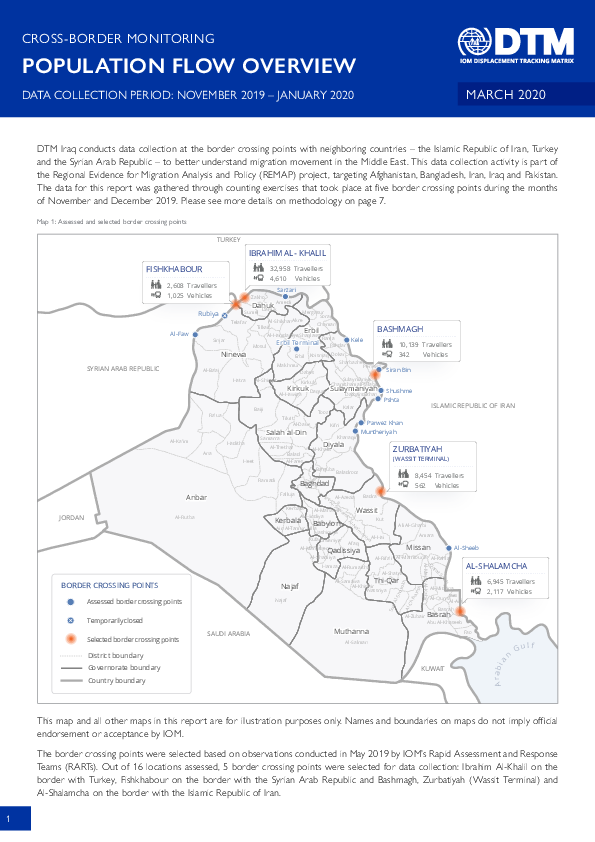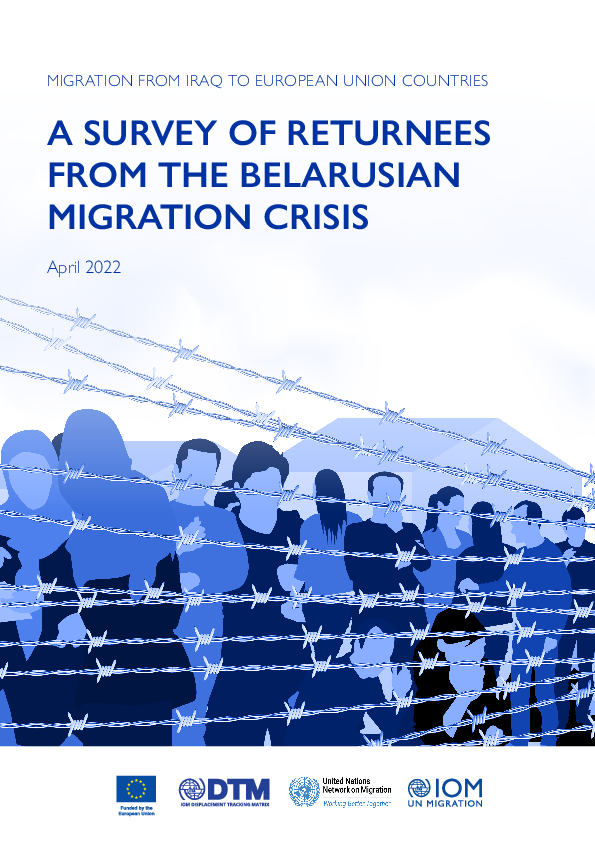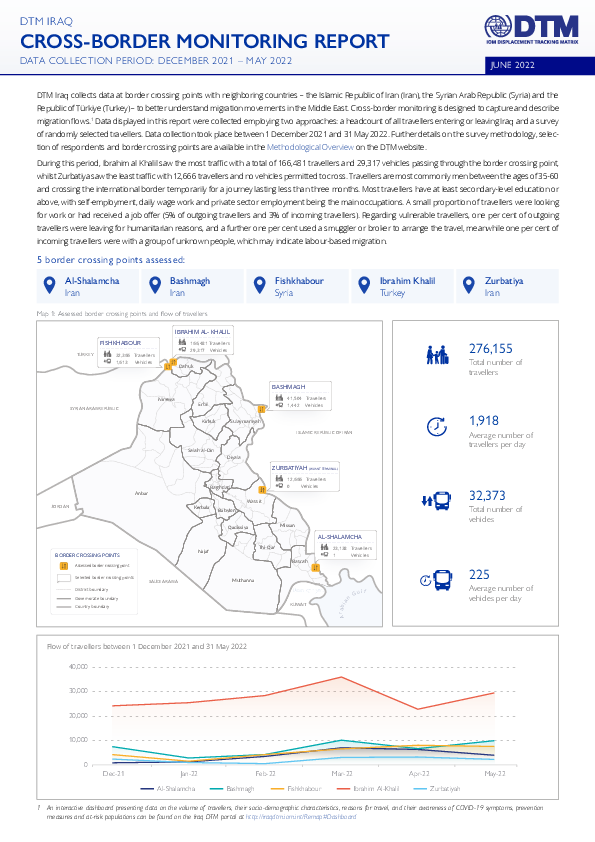-
Countries
-
Data and Analysis
-
Special Focus
-
Crisis Responses
Dashboard/Fact Sheet
Color
-

Contact
IraqDTM@iom.int
Language
English
Location
Iraq
Period Covered
Jun 01 2020
Aug 31 2020
Activity
- Survey
- Flow Monitoring
DTM Iraq collects data at border crossing points with neighboring countries – the Islamic Republic of Iran (Iran), the Syrian Arab Republic (Syria) and Turkey – to better understand migration movements in the Middle East. Cross-border monitoring is drawn from IOM’s DTM standard methodology, designed to capture and describe migration flows, and is part of IOM’s DTM Regional Evidence for Migration Analysis and Policy (REMAP) project, funded by the European Union, which aims to capture and describe migration flows in Afghanistan, Bangladesh, Iran, Iraq and Pakistan. Data displayed in this report was collected in June, July and August 2020, employing two approaches: 1) headcount of all travellers entering or leaving Iraq, and 2) survey of randomly sampled travellers.
Border crossing points were selected based on observations conducted in May 2019 by IOM’s Rapid Assessment and Response Teams (RARTs), when five border crossing points were selected for data collection: Ibrahim Al-Khalil, bordering Turkey, Fishkhabour, bordering Syria, and Bashmagh Zurbatiyah (Wassit Terminal) and Al-Shalamcha, bordering Iran. Due to mobility restrictions imposed by Iraqi authorities since March 2020 aimed at curbing the spread of the coronavirus disease 2019 (COVID-19), data collection took place at three out of five selected border points in June, July and August 2020. Further details on the selection of respondents, survey methodology, and how the border crossing points were selected are available in the Methodological Overview in the last section of this report.
The report presents an overview of the overall movements of travellers observed at any of three selected border crossing points during June, July and August 2020. It is also focused in more detail on those travellers who are crossing the border for three or more months – they are referred to as migrants and comprise 49 per cent of all recorded travellers. Findings presented in this report relate to sociodemographic characteristics, reasons for travel and mobility history of this category of travellers.

Contact
IraqDTM@iom.int
Language
English
Location
Iraq
Period Covered
Nov 01 2019
Jan 31 2020
Activity
- Survey
- Flow Monitoring
DTM Iraq conducts data collection at the border crossing points with neighboring countries – the Islamic Republic of Iran, Turkey and the Syrian Arab Republic – to better understand migration movement in the Middle East. This data collection activity is part of the Regional Evidence for Migration Analysis and Policy (REMAP) project, targeting Afghanistan, Bangladesh, Iran, Iraq and Pakistan. The data for this report was gathered through counting exercises that took place at five border crossing points during the months of November and December 2019.

Contact
IraqDTM@iom.int
Language
English
Location
Iraq
Period Covered
Jan 01 2020
Feb 29 2020
Activity
- Survey
- Flow Monitoring
DTM Iraq collects data at border crossing points with neighboring countries – the Islamic Republic of Iran (Iran), the Syrian Arab Republic (Syria) and Turkey – to better understand migration movements in the Middle East. Cross-border monitoring is drawn from IOM’s DTM standard methodology designed to capture and describe migration flows, and is part of IOM’s DTM Regional Evidence for Migration Analysis and Policy (REMAP) project, funded by the European Union, which aims to capture and describe migration flows in Afghanistan, Bangladesh, Iran, Iraq and Pakistan. Data displayed in this report was collected at five border point crossings in January and February 2020, employing two different approaches: 1) headcount of all travellers entering or leaving Iraq, and 2) survey of randomly sampled travellers. Border crossing points were selected based on observations conducted in May 2019 by IOM’s Rapid Assessment and Response Teams (RARTs). Out of 16 locations observed, five border crossing points were selected for data collection: Ibrahim Al-Khalil, bordering Turkey, Fishkhabour, bordering Syria, and Bashmagh, Zurbatiyah (Wassit Terminal) and Al-Shalamcha, bordering Iran. Further details on the selection of respondents, survey methodology, and how the border crossing points were selected are available in the Methodological Overview in the last section of this report.
The report presents an overview of the overall movements of travellers observed at any of five selected border crossing points during January and February 2020. It is also focused in more detail on those travellers who are crossing the border for three or more months – they are referred to as migrants and comprise 12 per cent of all recorded travellers. Findings presented in this report relate to socio-demographic characteristics, reasons for travel and mobility history of this category of travellers.

Contact
IraqDTM@iom.int
Language
English
Location
Iraq
Period Covered
Sep 01 2020
Sep 30 2021
Activity
- Survey
- Flow Monitoring
DTM Iraq collects data at border crossing points with neighbouring countries – the Islamic Republic of Iran (Iran), the Syrian Arab Republic (Syria) and Turkey – to better understand migration movements in the Middle East. Cross-border monitoring is designed to capture and describe migration flows, and is part of IOM DTM’s Regional Evidence for Migration Analysis and Policy (REMAP) project, funded by the European Union. The project aims to capture and describe migration flows in Afghanistan, Bangladesh, Iran, Iraq and Pakistan. The United Nations Development Assistance Framework (UNDAF) funded this piece of research.
This report seeks to identify migrants in vulnerable situations entering and departing Iraq who may be susceptible to trafficking in persons and/or other forms of abuse, violence and exploitation along their migratory journey. The aim is to gain a better understanding of the profile of the vulnerable groups, the means of organizing travel, push-factors in the decision-making process, level of risk-awareness and problems encountered during the journey.
Data displayed in this report were collected using two approaches: a headcount of all travellers entering or departing Iraq though the specified border points where DTM have data collection teams stationed and a survey of randomly selected travellers. Data collection took place between 1 September 2020 and 30 September 2021 at five border crossing points: Ibrahim Al-Khalil, bordering Turkey, Fishkhabour, bordering Syria, and Bashmagh, Zurbatiyah (Wassit Terminal) and Al-Shalamcha, bordering Iran. During this period, a total of 14,598 interviews were conducted with randomly selected travellers entering and departing Iraq.

Contact
IraqDTM@iom.int
Language
English
Location
Iraq
Period Covered
Feb 01 2022
Feb 28 2022
Activity
- Survey
- Flow Monitoring
During the recent migration crisis in Belarus, thousands of Iraqis experienced harassment, exposure and violence. Many returned, via IOM
facilitated movements through the Assisted Voluntary Return and Reintegration (AVRR) programme and via movements organised and supported by the Government of Iraq from Belarus and neighbouring countries of the European Union (EU). Potential emigrants from Iraq began to travel to Belarus, Lithuania, Latvia and Poland in large numbers in the second half of 2021. In the context of negotiations between the Government of Belarus and the EU, the Government of Belarus’ relaxation of visa policies and a travel information campaign in Iraq, there was a significant increase in the number of potential emigrants from Iraq travelling to Belarus. Many of those potential emigrants travelled with the intention of onward travel to enter the European Union or the United Kingdom.
With the suspension of flights from Baghdad to Belarus in August 2021, potential emigrants from Iraq began to use alternative routes to reach
Belarus and neighbouring EU countries, including from airports in Erbil and Sulaymaniyah. The increase of Iraqi emigrants entering Belarus resulted in a crisis when Belarusian security forces began to move migrants to the country’s borders with Poland, Lithuania and Latvia. This was accompanied by reports of violence and abuse against Iraqi migrants at the border, many of whom were reportedly unable to move into Europe or back into Belarus. As a result, the Government of Iraq (GoI), facilitated the return of approximately 3,800 Iraqi migrants. The International Organisation for Migration (IOM), with the support of the European Union, have continued to facilitate the voluntary return of Iraqi migrants from Belarus and EU countries.

Contact
DTM Pakistan, iomisbdtmremapteam@iom.int
Language
English
Location
Pakistan
Period Covered
Apr 01 2024
Apr 15 2024
Activity
- Flow Monitoring
The International Organization for Migration (IOM) in Pakistan collects data on the outflows of Afghans at the Torkham (Khyber Pakhtunkhwa), Badini, Bahramcha, and Chaman (Balochistan) border crossing points (BCPs) to better understand the movements of Afghans returning to Afghanistan. The data is harmonized with those from the United Nations High Commissioner for Refugees (UNHCR), who also cover the Ghulam Khan (Khyber Pakhtunkhwa) BCP.
On 26 September 2023, the Ministry of Interior in Pakistan announced its decision to enact its “Illegal Foreigners’ Repatriation Plan (IFRP)”. Between 1 and 15 April 2024, a total of 8,261 Afghan nationals returned to Afghanistan, including 6,770 through the Torkham BCP, 877 through the Chaman BCP, and 614 through the Ghulam Khan BCP, while no Afghan nationals returned through the Badini and Bahramcha BCPs. In addition, border authorities deported 71 individuals due to a lack of valid documentation. Since 1 January 2024, IOM identified 62,559 returns at the four BCPs.

Contact
DTM Burundi, DTMBurundi@iom.int
Language
English
Location
Burundi
Period Covered
Apr 08 2024
Apr 15 2024
Activity
- Mobility Tracking
- Event Tracking
Le rapport DTM indique qu'entre le 8 et le 14 avril 2024, au Burundi, 13 674 personnes ont été affectées et 3 715 déplacées suite à des pluies torrentielles, des glissements de terrain, des inondations et des vents violents nécessitant une réponse immédiate de la communauté humanitaire. Parmi les affectés, 7 546 sont des femmes et 6 128 sont des hommes. La répartition par type d'urgence montre que les pluies torrentielles ont affecté 6 983 personnes et en ont déplacé 2 507, les glissements de terrain ont affecté 6 046 personnes et en ont déplacé 793, les inondations ont affecté 359 personnes et en ont déplacé 256, et les vents violents ont affecté 286 personnes et en ont déplacé 159. Les groupes vulnérables comprennent 122 femmes enceintes ou allaitantes, 3 hommes seuls chefs de ménage, 7 personnes avec une maladie chronique, 15 personnes handicapées et 10 personnes âgées vivant seules. Les dommages incluent de nombreuses habitations ainsi que des infrastructures telles que des écoles, des églises et des bâtiments administratifs. Cette situation met en lumière la nécessité d'une aide humanitaire continue et ciblée dans la région.

Contact
iomguatemala@iom.int
Language
English
Location
Guatemala
Period Covered
Feb 01 2024
Feb 29 2024
Activity
- Flow Monitoring
In Februrary 2024, 22,402 movements were observed in Guatemala (18% children) and 400 individuals were surveyed.1 The number of observed movements decreased by 6 per cent from January 2024 (23,690) due to operational constraints in data collection. More than half of surveyed individuals originated from the Bolivarian Republic of Venezuela (63%). The main intended destination was the United States of America (90%).
Since 2022, migratory flows through the Latin America and Caribbean region have increased significantly, with record levels of persons crossing the perilous jungle of the Darién National Park from Colombia into Panama. The in-transit flows tracked in Guatemala have mirrored these regional migration trends.

Contact
iomguatemala@iom.int
Language
English
Location
Guatemala
Period Covered
Feb 01 2024
Feb 29 2024
Activity
- Flow Monitoring
En febrero de 2024 se observaron 22,402 movimientos en Guatemala (18% niños, niñas y adolescentes) y 400 personas fueron encuestadas.1 El número de movimientos observados disminuyó un 6 por ciento desde enero de 2024 (23,690) debido a limitaciones operativas en la recolección de datos. Más de la mitad de las personas encuestadas procedía de la República Bolivariana de Venezuela (63%). El principal destino previsto fue los Estados Unidos de América (90%).
Desde 2022, los flujos de migrantes en tránsito se incrementaron significativamente en la región de América Latina y el Caribe, observando cantidades nunca antes registradas de personas que cruzan la peligrosa selva del Parque Nacional del Darién desde Colombia hacia Panamá. Los flujos en tránsito observados en Guatemala han reflejado dichas tendencias migratorias regionales

Contact
IraqDTM@iom.int
Language
English
Location
Iraq
Period Covered
Dec 01 2021
May 30 2022
Activity
- Survey
- Flow Monitoring
DTM Iraq collects data at border crossing points with neighboring countries – the Islamic Republic of Iran (Iran), the Syrian Arab Republic (Syria) and the Republic of Türkiye (Turkey) – to better understand migration movements in the Middle East. Cross-border monitoring is designed to capture and describe migration flows. Data displayed in this report were collected employing two approaches: a headcount of all travellers entering or leaving Iraq and a survey of randomly selected travellers. Data collection took place between 1 December 2021 and 31 May 2022. Further details on the survey methodology, selection of respondents and border crossing points are available in the Methodological Overview on the DTM website.
During this period, Ibrahim al Khalil saw the most traffic with a total of 166,481 travellers and 29,317 vehicles passing through the border crossing point, whilst Zurbatiya saw the least traffic with 12,666 travellers and no vehicles permitted to cross. Travellers are most commonly men between the ages of 35-60 and crossing the international border temporarily for a journey lasting less than three months. Most travellers have at least secondary-level education or above, with self-employment, daily wage work and private sector employment being the main occupations. A small proportion of travellers were looking for work or had received a job offer (5% of outgoing travellers and 3% of incoming travellers). Regarding vulnerable travellers, one per cent of outgoing travellers were leaving for humanitarian reasons, and a further one per cent used a smuggler or broker to arrange the travel, meanwhile one per cent of incoming travellers were with a group of unknown people, which may indicate labour-based migration.
Pagination
- Previous page
- Page 18
- Next page